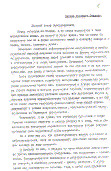
 Letter from Gorky to Stalin
Letter from Gorky to Stalin
The Soviet Union was the first state to have as an ideological objective the elimination of religion. Toward that end, the Communist regime confiscated church property, ridiculed religion, harassed believers, and propagated atheism in the schools. Actions toward particular religions, however, were determined by State interests, and most organized religions were never outlawed.
The main target of the anti-religious campaign in the 1920s and 1930s was the Russian Orthodox Church, which had the largest number of faithful. Nearly all of its clergy, and many of its believers, were shot or sent to labor camps. Theological schools were closed, and church publications were prohibited. By 1939 only about 500 of over 50,000 churches remained open.
After Nazi Germany's attack on the Soviet Union in 1941, Joseph Stalin revived the Russian Orthodox Church to intensify patriotic support for the war effort. By 1957 about 22,000 Russian Orthodox churches had become active. But in 1959 Nikita Khrushchev initiated his own campaign against the Russian Orthodox Church and forced the closure of about 12,000 churches. By 1985 fewer than 7,000 churches remained active. Members of the church hierarchy were jailed or forced out, their places taken by docile clergy, many of whom had ties with the KGB.
Campaigns against other religions were closely associated with particular nationalities, especially if they recognized a foreign religious authority such as the Pope. By 1926, the Roman Catholic Church had no bishops left in the Soviet Union, andby 1941 only two of the almost 1,200 churches that had existed in 1917, mostly in Lithuania, were still active. The Ukrainian Catholic Church (Uniate), linked with Ukrainian nationalism, was forcibly subordinated in 1946 to the Russian Orthodox Church, and the Autocephalous Orthodox Churches of Belorussia and Ukraine were suppressed twice, in the late 1920s and again in 1944.
Attacks on Judaism were endemic throughout the Soviet period, and the organized practice of Judaism became almost impossible. Protestant denominations and other sects were also persecuted. The All-Union Council of Evangelical Christian Baptists, established by the government in 1944, typically was forced to confine its activities to the narrow act of worship and denied most opportunities for religious teaching and publication. Fearful of a pan-Islamic movement, the Soviet regime systematically suppressed Islam by force, until 1941. The Nazi invasion of the Soviet Union that year led the government to adopt a policy of official toleration of Islam while actively encouraging atheism among Muslims.
Next is a letter of March 19, 1922, from Lenin via Molotov to members of the Politburo, outlining a brutal plan of action against the "Black Hundreds" clergy and their followers, who were defying the government decree to remove church valuables (purported by the government to be used to fund famine relief). Lenin proposed the arrest and quick trial of the insurrectionists in Shuia, followed by a ruthless campaign to shoot a large number of the reactionary clergy and bourgeoisie and urged that removal of valuables from the richest churches and monasteries be finished quickly.

Please follow the guided tour or have a look at one of these showcases:
When you have seen them all you should walk back to the entrance hall.